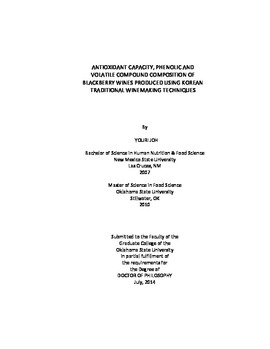| dc.contributor.advisor | McGlynn, William G. | |
| dc.contributor.author | Joh, Youri | |
| dc.date.accessioned | 2015-06-17T20:06:26Z | |
| dc.date.available | 2015-06-17T20:06:26Z | |
| dc.date.issued | 2014-07 | |
| dc.identifier.uri | https://hdl.handle.net/11244/14911 | |
| dc.description.abstract | This research project was designed to evaluate the winemaking potential of `Natchez' and `Triple Crown' blackberries grown in Oklahoma as well as to examine the measurable basic physical properties and potential health-benefits of phenolic compounds in blackberry wines made using traditional Korean winemaking techniques with variations in fermentation temperature (21.6?C vs. 26.6?C), and fermentation type (yeast inoculation vs. wild-type fermentation). Korean traditional wine processing methods, which typically employ wild-type microorganisms for fermentation, may provide different types and levels of health-related compounds than common wine production methods. The pH, titratable acidity, soluble solids, and percent alcohol of blackberry juice and wine samples were measured as basic physical properties. The Harbertson-Adams assay, oxygen radical absorbance capacity (ORAC), high performance liquid chromatography (HPLC), and gas chromatography (GC) of blackberry juice and wine samples were investigated as indicators of health benefits of phenolic compounds, primarily antioxidant potential. Total percent fat of whole blackberries and pomace was also analyzed. | |
| dc.description.abstract | Among physical properties, `Triple Crown' wines made at the higher fermentation temperature were sweeter and had higher alcohol concentrations than `Natchez' wines. `Natchez' berries had higher percent total fat than `Triple Crown' berries. `Natchez' juices and wines generally had higher concentrations of total phenolics, tannins, and anthocyanins while `Triple Crown' juices and wines generally had higher concentrations of polymeric pigments, phenolic acids, and free volatile compounds. `Triple Crown' wines also generally exhibited higher antioxidant activity. Examining the two fermentation temperatures, 26.6°C increased the initial concentration of phenolics in the wines. However, wines fermented at 21.6°C showed less loss of phenolics during aging. Between two fermentation types, wild-type fermentation had higher phenolic concentrations than yeast inoculated wines. | |
| dc.description.abstract | Overall, the traditional Korean winemaking technique examined in this study provided good production and retention of phenolic compound and volatile aroma compounds in the wines and that the wines produced were high in antioxidant capacity. | |
| dc.format | application/pdf | |
| dc.language | en_US | |
| dc.rights | Copyright is held by the author who has granted the Oklahoma State University Library the non-exclusive right to share this material in its institutional repository. Contact Digital Library Services at lib-dls@okstate.edu or 405-744-9161 for the permission policy on the use, reproduction or distribution of this material. | |
| dc.title | Antioxidant capacity, phenolic and volatile compound composition of blackberry wines produced using Korean traditional wine-making techniques | |
| dc.contributor.committeeMember | Maness, Niels O. | |
| dc.contributor.committeeMember | Smith, Michael Wayne | |
| dc.contributor.committeeMember | Bowser, Tim | |
| osu.filename | Joh_okstate_0664D_13567.pdf | |
| osu.accesstype | Open Access | |
| dc.type.genre | Dissertation | |
| dc.type.material | Text | |
| thesis.degree.discipline | Food Science | |
| thesis.degree.grantor | Oklahoma State University | |
